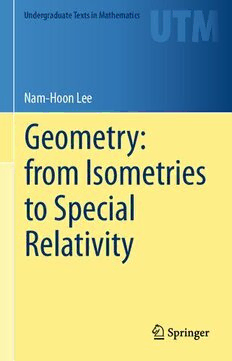
Geometry: From Isometries to Special Relativity PDF
Preview Geometry: From Isometries to Special Relativity
Undergraduate Texts in Mathematics Nam-Hoon Lee Geometry: from Isometries to Special Relativity Undergraduate Texts in Mathematics Undergraduate Texts in Mathematics SeriesEditors SheldonAxler SanFranciscoStateUniversity,SanFrancisco,CA,USA KennethRibet UniversityofCalifornia,Berkeley,CA,USA AdvisoryBoard ColinAdams,WilliamsCollege,Williamstown,MA,USA L.CraigEvans,UniversityofCalifornia,Berkeley,CA,USA PamelaGorkin,BucknellUniversity,Lewisburg,PA,USA RogerE.Howe,YaleUniversity,NewHaven,CT,USA MichaelE.Orrison,HarveyMuddCollege,Claremont,CA,USA LisetteG.dePillis,HarveyMuddCollege,Claremont,CA,USA JillPipher,BrownUniversity,Providence,RI,USA JessicaSidman,MountHolyokeCollege,SouthHadley,MA,USA Undergraduate Texts in Mathematics are generally aimed at third- and fourth- year undergraduate mathematics students at North American universities. These texts strive to provide students and teachers with new perspectives and novel approaches.Thebooksincludemotivationthatguidesthereadertoanappreciation ofinterrelationsamongdifferentaspectsofthesubject.Theyfeatureexamplesthat illustratekeyconceptsaswellasexercisesthatstrengthenunderstanding. Moreinformationaboutthisseriesathttp://www.springer.com/series/666 Nam-Hoon Lee Geometry: from Isometries to Special Relativity Nam-HoonLee DepartmentofMathematicsEducation HongikUniversity Seoul,Korea(Republicof) ISSN0172-6056 ISSN2197-5604 (electronic) UndergraduateTextsinMathematics ISBN978-3-030-42100-7 ISBN978-3-030-42101-4 (eBook) https://doi.org/10.1007/978-3-030-42101-4 MathematicsSubjectClassification(2020):51-01,51M10,51B20,51F15,83A05,51P05,53B30 ©SpringerNatureSwitzerlandAG2020 Thisworkissubjecttocopyright.AllrightsarereservedbythePublisher,whetherthewholeorpartof thematerialisconcerned,specificallytherightsoftranslation,reprinting,reuseofillustrations,recitation, broadcasting,reproductiononmicrofilmsorinanyotherphysicalway,andtransmissionorinformation storageandretrieval,electronicadaptation,computersoftware,orbysimilarordissimilarmethodology nowknownorhereafterdeveloped. Theuseofgeneraldescriptivenames,registerednames,trademarks,servicemarks,etc.inthispublication doesnotimply,evenintheabsenceofaspecificstatement,thatsuchnamesareexemptfromtherelevant protectivelawsandregulationsandthereforefreeforgeneraluse. Thepublisher,theauthors,andtheeditorsaresafetoassumethattheadviceandinformationinthisbook arebelievedtobetrueandaccurateatthedateofpublication.Neitherthepublishernortheauthorsor theeditorsgiveawarranty,expressedorimplied,withrespecttothematerialcontainedhereinorforany errorsoromissionsthatmayhavebeenmade.Thepublisherremainsneutralwithregardtojurisdictional claimsinpublishedmapsandinstitutionalaffiliations. ThisSpringerimprintispublishedbytheregisteredcompanySpringerNatureSwitzerlandAG Theregisteredcompanyaddressis:Gewerbestrasse11,6330Cham,Switzerland Tomydaughter,Kyuri Preface This book is intended for undergraduate students who have some working knowl- edge of elementary calculus. It covers the geometries of various two-dimensional homogeneous spaces with metrics—i.e., the Euclidean plane, the sphere, the hyperbolicplane,andtheLorentz–Minkowskiplane,whichisthetwo-dimensional spacetime that arises from the theory of special relativity. Our main purpose is to introduceabstractspaces,suchasthehyperbolicplaneandtheLorentz–Minkowski plane,toundergraduatestudentsaseasilyandintuitivelyaspossible.Westartwith very intuitive spaces, the Euclidean plane and the sphere, and focus on a specific structuretheoremforisometries(Theorems1.6,2.7,4.20,and5.7),inwhichevery isometry is a composition of at most three (or four for the Lorentz–Minkowski plane)reflections.Thistheoremappearsinverysimilarformsinallfourspaces,and theproofsforthemcanalsobepresentedinasimilarfashion.Wepresentgeometric proofs of these reflection theorems for the first two intuitive spaces and gradually transittothelattertwoabstractspaces.Althoughsometerminologiesaredifferent andmoreabstract,thebasicstructureofthetheoremremainsthesame.Ourstrategy istofamiliarizethereaderswiththetheoremsandlogicoftheproofsfirstinthetwo intuitivespacesandtothenstudythetheorems,havingsimilarstructuresandlogic, for the two abstract spaces so that the transition from concrete spaces to abstract spacescanbemadeeasilyandsmoothly. In addition to the concentration on the reflection theorem, another difference betweenthisbookandothersimilarbooksongeometryisthatittreatsthegeometry of special relativity from a truly geometric viewpoint, employing tools that can be used by undergraduate students. Special relativity is an experimentally well confirmed and universally accepted physical theory that explains how space and time are linked. It replaces the primitive notion of an absolute universal time by thenotionofarelativetimethatisnotindependentofthereferenceframeandthe spatialposition.Ratherthantreatingtheinvarianttimeandinvariantspatialintervals betweentwoeventsseparately,oneneedstoconsideraninvariantspacetimeinterval, which enables us to understand the spacetime from a geometric view of distances andisometries. vii viii Preface It is not easy for undergraduate students to approach the geometry of special relativity. The existing books exploit tools that are too difficult for beginning undergraduates to follow or do not provide a truly geometric viewpoint, depicting only some physical consequences of the theory. We amalgamate special relativity, asanotherinterestinggeometry,withclassicalgeometries,notingthefollowingtwo points. First,asimilartypeofreflectiontheoremholdsforthespaceofspecialrelativity. We repeat a logically similar proof of the theorem given for classical spaces. We think that this similarity helps the reader approach the geometry of special relativitywithoutreluctance.Althoughwemainlyfocusonthestructuretheoremsof isometries,readerswillalsounderstandotheraspectsofthegeometryofthespaces duringtheirstudy. Second, the three-dimensional spacetime of special relativity contains a hyper- surface (ahyperboloid) that is isometric with the hyperbolic plane. Itis always an interestingtasktoconnecttwosubjectsthatinitiallyseemcompletelydifferent.We concretely explain this connection and give a thorough description. This will help readersprepareformoreadvancedsubjects,suchashigherdimensionalhyperbolic geometry. The structure of the book is as follows: In Chapter 1, we introduce the basic geometric terminologies in the familiar Euclidean geometry, such as distance, isometry, translation, reflection, rotation, orientation, and a fixed point. We also introducethereflectiontheoremandotherstructuretheoremsforisometries.Since ourpurposeistointroduceabstractspacestostudentsusingsimilaritiestointuitive spaces,wetrytokeepthediscussionwithinstudiesonisometries.InChapter2,we transittoanotherclassicalandintuitivegeometry,thesurfaceofthesphere.These theorems and the proofs continue to appeal to geometric intuition. At this point, the readers will start to note that the theorems and proofs for the sphere are very similar to those for the Euclidean plane. Chapter 3 deals with the stereographic projection and inversions. We introduce and prove some properties of inversions. Unlikeotherbooks,wetrytoprovidearepresentationofthegeometryofthesphere in the extended plane, following the perspectives of Henri Poincaré, which, we hope, helps the readers understand why we must use abstract metrics for some spaces. In Chapter 4, we deal with hyperbolic geometry. Although the treatment isstandard,wetrytokeeptheprerequisiteforthischapterminimal.Wedonotuse thenotionofcomplexnumbers.InChapter5,weintroducetheLorentz–Minkowski plane, which is the two-dimensional space of special relativity. We keep the same structure,i.e.,wedefinesimilarterminologiesandprovethetheoremusingasimilar logical structure. After we are familiarized with the geometry of special relativity, weshowthatthehyperboloidinthree-dimensionalspacetimeisactuallyisometric withthehyperbolicplane.Finally,inChapter6,weexplorethegeometryofspecial relativity.Wedefinebasicnotionssuchascausality,worldline,four-vector,andfour- momentum.Somebasicprinciplesofrelativistickinematicswillbetouchedupon. Solvingexercisesisthemostimportantpartoflearningmathematics.Theresultsof someexercisesareusedinthetextandsomeinterestingfactsarestatedinexercises. Thesolutionsforsomeselectedexercisesareprovidedattheendofthebook. Preface ix This book has evolved from notes used in courses at Hongik University. I am gratefultoallthestudentswhohavemadevariousvaluablecommentsonthenotes. Particularly, Yeun Kim, Kayun Kim, Jungsoo Nah, and Daun Kim noted several critical errors. My niece, Da Hyee Choi, drew several figures. Several colleagues of mine read it and provided remarks, suggestions, and criticisms. I would like to express my sincere thanks to Prof. Gabjin Yun, Dr. Kyoung-Tark Kim, Dr. Hyejin Park, Sokmin Hong, and Hyelyn Choi. Suggestions, corrections, or comments are [email protected]. Seoul,SouthKorea Nam-HoonLee March2020 Contents 1 EuclideanPlane .............................................................. 1 1.1 Isometries................................................................ 1 1.2 ThreeReflectionsTheorem............................................. 6 1.3 RotationsandTranslations.............................................. 11 1.4 GlideReflectionsandOrientation...................................... 17 2 Sphere......................................................................... 23 2.1 TheSphereS2inR3 .................................................... 23 2.2 IsometriesoftheSphereS2............................................. 29 2.3 AreaofaSphericalTriangle............................................ 36 2.4 OrthogonalTransformationsofEuclideanSpaces .................... 43 3 StereographicProjectionandInversions.................................. 47 3.1 StereographicProjection................................................ 47 3.2 InversionsontheExtendedPlane ...................................... 56 3.3 InversionsontheSphereS2 ............................................ 68 3.4 RepresentationoftheSphereintheExtendedPlane.................. 77 4 HyperbolicPlane............................................................. 87 4.1 PoincaréUpperHalf-PlaneH2 ......................................... 87 4.2 H2-ShortestPathsandH2-Lines ....................................... 93 4.3 IsometriesoftheHyperbolicPlane..................................... 100 4.4 HyperbolicTriangleandHyperbolicArea............................. 106 4.5 PoincaréDisk............................................................ 112 4.6 KleinDisk............................................................... 119 4.7 Euclid’sFifthPostulate:TheParallelPostulate ....................... 122 5 Lorentz–MinkowskiPlane.................................................. 129 5.1 Lorentz–MinkowskiDistance .......................................... 130 5.2 RelativisticReflections ................................................. 135 5.3 HyperbolicAngle ....................................................... 142 5.4 RelativisticRotations ................................................... 149 5.5 MatrixandIsometry .................................................... 154 xi
